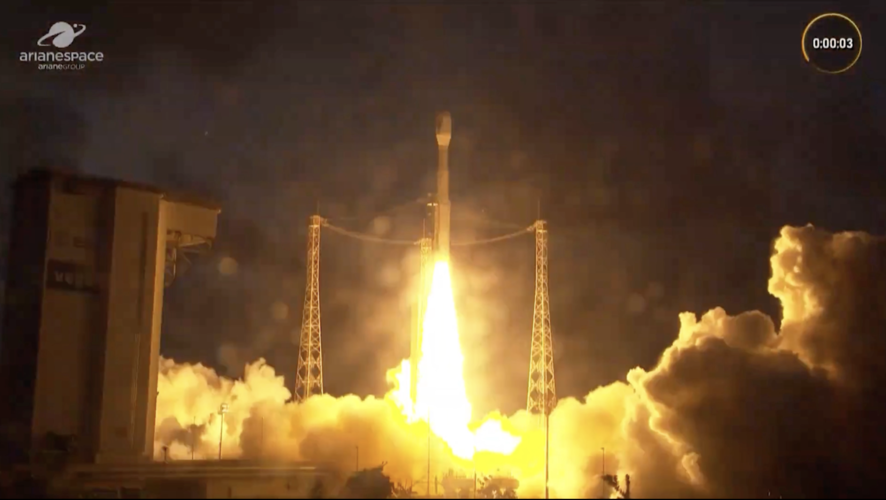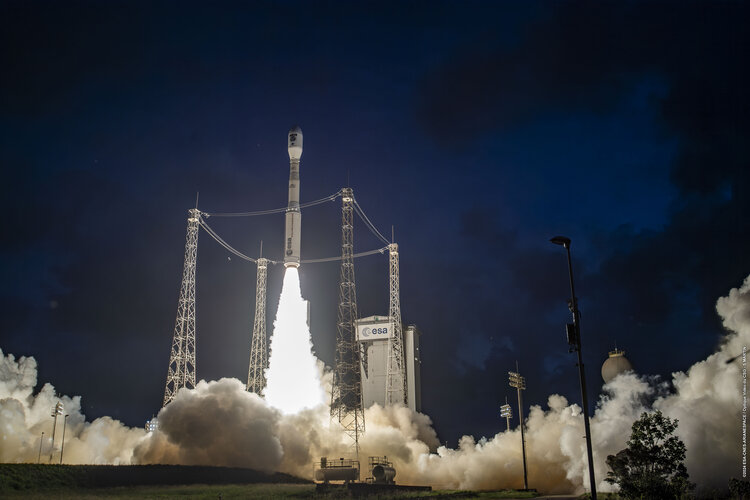
Copernical Team
Europe's troubled Vega-C rocket launches after delays
 Europe's new Vega-C rocket launched Thursday from French Guiana in its first takeoff since a failed flight two years ago, an AFP correspondent said.
After days of delays, the rocket took off without problems, carrying the Sentinel-1C satellite for the European Union's Copernicus Earth observation programme.
It is the first blastoff for the lightweight rocket since December 2022, when it
Europe's new Vega-C rocket launched Thursday from French Guiana in its first takeoff since a failed flight two years ago, an AFP correspondent said.
After days of delays, the rocket took off without problems, carrying the Sentinel-1C satellite for the European Union's Copernicus Earth observation programme.
It is the first blastoff for the lightweight rocket since December 2022, when it Sentinel-1C launches on Vega-C
 Video:
00:02:40
Video:
00:02:40
The third Copernicus Sentinel-1 satellite, Sentinel-1C, has launched aboard a Vega-C rocket, flight VV25, from Europe’s Spaceport in French Guiana. The rocket lifted off on 5 December 2024 at 22:20 CET (18:20 local time).
Sentinel-1C extends the legacy of its predecessors, delivering high-resolution radar imagery to monitor Earth’s changing environment, supporting a diverse range of applications and advance scientific research. Additionally, Sentinel-1C introduces new capabilities for detecting and monitoring maritime traffic.
The launch also marks Vega-C’s ‘return to flight’, a key step in restoring Europe’s independent access to space. Vega-C is the evolution of the Vega family of rockets and delivers increased performance, greater payload volume and improved competitiveness.
Double win for Europe: Sentinel-1C and Vega-C take to the skies

The third Copernicus Sentinel-1 satellite was launched on a Vega-C rocket from Europe’s Spaceport in French Guiana. Sentinel-1C extends the legacy of its predecessors, delivering high-resolution radar imagery to monitor Earth’s changing environment, supporting a diverse range of applications and advancing scientific research. Additionally, Sentinel-1C introduces new capabilities for detecting and monitoring maritime traffic.
The power of two: Proba-3
 Video:
00:02:32
Video:
00:02:32
ESA’s eclipse-making Proba-3 double satellite mission has made it to space! Learn more about Proba-3 from the mission team as they bid farewell to their spacecraft, while ESA's Director General Josef Aschbacher wishes the team the best of luck.
The latest member of ESA’s family of in-orbit demonstration missions, Proba-3 is in fact two spacecraft being launched together, which will perform precise formation flying, accurate to a single millimetre, about the thickness of an average fingernail. To prove their performance, Proba-3 has been devoted to an ambitious scientific goal. The pair will line up precisely with the Sun
India launches European 'artifical eclipse' satellites
 India on Thursday successfully launched into space a pair of European satellites that will create artificial solar eclipses to help scientists catch a rare glimpse of the Sun's mysterious atmosphere.
Scientists broke into rapturous applause at the Sriharikota launch site as the Indian Space Research Organisation (ISRO) chief announced the spacecraft had been ejected as planned.
"The spac
India on Thursday successfully launched into space a pair of European satellites that will create artificial solar eclipses to help scientists catch a rare glimpse of the Sun's mysterious atmosphere.
Scientists broke into rapturous applause at the Sriharikota launch site as the Indian Space Research Organisation (ISRO) chief announced the spacecraft had been ejected as planned.
"The spac FibreCoat raises 20m euro to advance coated fiber technology in space and defense sectors
 FibreCoat, a leading innovator in materials technology, has successfully raised nearly euro 20 million in a Series B funding round. The investment was co-led by NewSpace Capital and Goose Capital, with participation from Nova Saint-Gobain, 212 NexT, Otto Krahn New Business, Convergent Ventures, and TiE.
Founded in Germany in 2020, FibreCoat has developed a pioneering process for coating f
FibreCoat, a leading innovator in materials technology, has successfully raised nearly euro 20 million in a Series B funding round. The investment was co-led by NewSpace Capital and Goose Capital, with participation from Nova Saint-Gobain, 212 NexT, Otto Krahn New Business, Convergent Ventures, and TiE.
Founded in Germany in 2020, FibreCoat has developed a pioneering process for coating f European mission to imitate solar eclipse launches from India
 A European mission launched from India on Thursday, aiming to catch a rare glimpse of the Sun's mysterious atmosphere by imitating a solar eclipse using two satellites flying with millimetre-level precision.
The European Space Agency's Proba-3 mission blasted off on a Indian rocket from a launchpad on the island of Sriharikota at around 4:04 pm (1034 GMT), an online broadcast showed.
Aro
A European mission launched from India on Thursday, aiming to catch a rare glimpse of the Sun's mysterious atmosphere by imitating a solar eclipse using two satellites flying with millimetre-level precision.
The European Space Agency's Proba-3 mission blasted off on a Indian rocket from a launchpad on the island of Sriharikota at around 4:04 pm (1034 GMT), an online broadcast showed.
Aro Eclipse-making double satellite Proba-3 enters orbit

A pair of spacecraft were launched together today from India with the potential to change the nature of future space missions. ESA’s twin Proba-3 platforms will perform precise formation flying down to a single millimetre, as if they were one single giant spacecraft. To demonstrate their degree of control, the pair will produce artificial solar eclipses in orbit, giving prolonged views of the Sun’s ghostly surrounding atmosphere, the corona.
Proba-3 lift-off replay
 Video:
00:02:27
Video:
00:02:27
ESA’s Proba-3 mission lifted off on its PSLV-XL rocket from Satish Dhawan Space Centre in Sriharikota, India, on Thursday, 5 December, at 11:34 CET (10:34 GMT, 16:04 local time).
Searching for evidence of primordial black holes in planets and everyday materials
 The formation of black holes is often associated with massive stars collapsing under their own gravity. However, new research suggests the chaotic conditions of the early universe may have enabled the creation of primordial black holes (PBHs) long before stars existed. These PBHs, theorized to account for elusive dark matter, remain undetected despite decades of speculation.
A study co-led
The formation of black holes is often associated with massive stars collapsing under their own gravity. However, new research suggests the chaotic conditions of the early universe may have enabled the creation of primordial black holes (PBHs) long before stars existed. These PBHs, theorized to account for elusive dark matter, remain undetected despite decades of speculation.
A study co-led 
